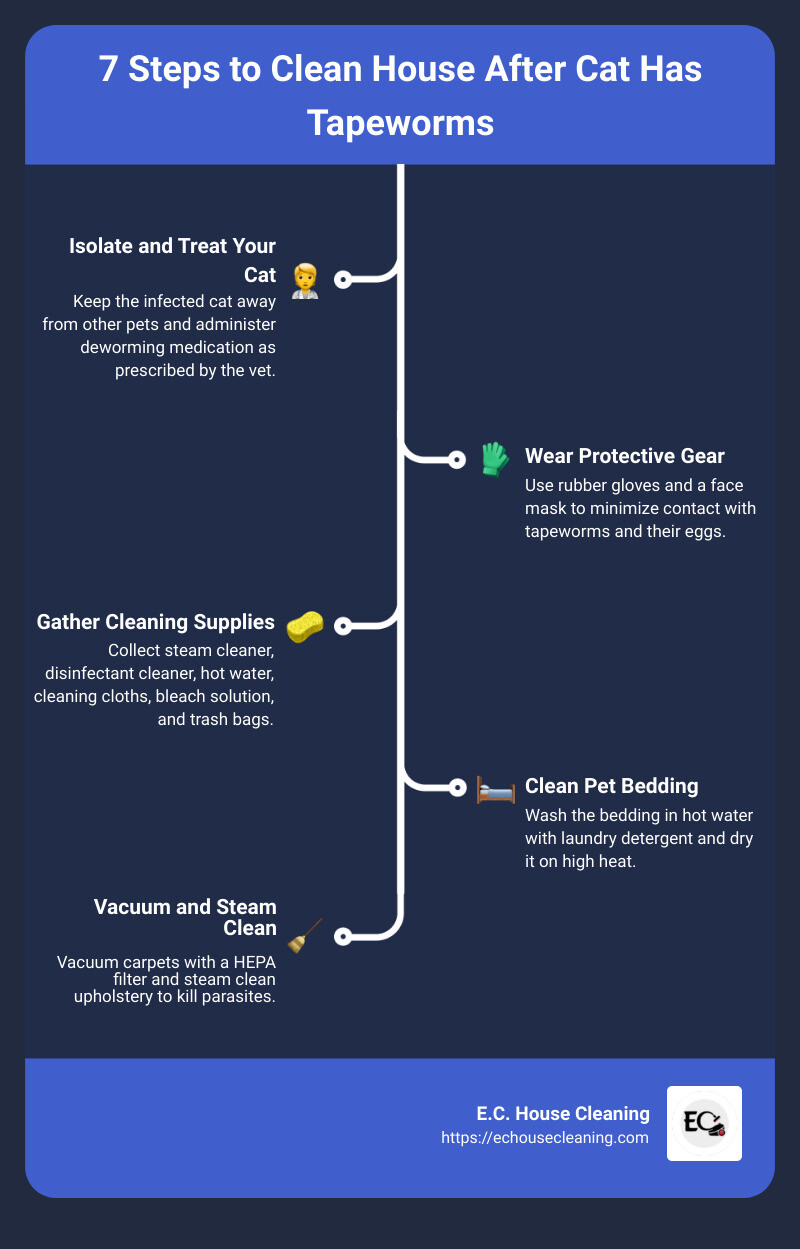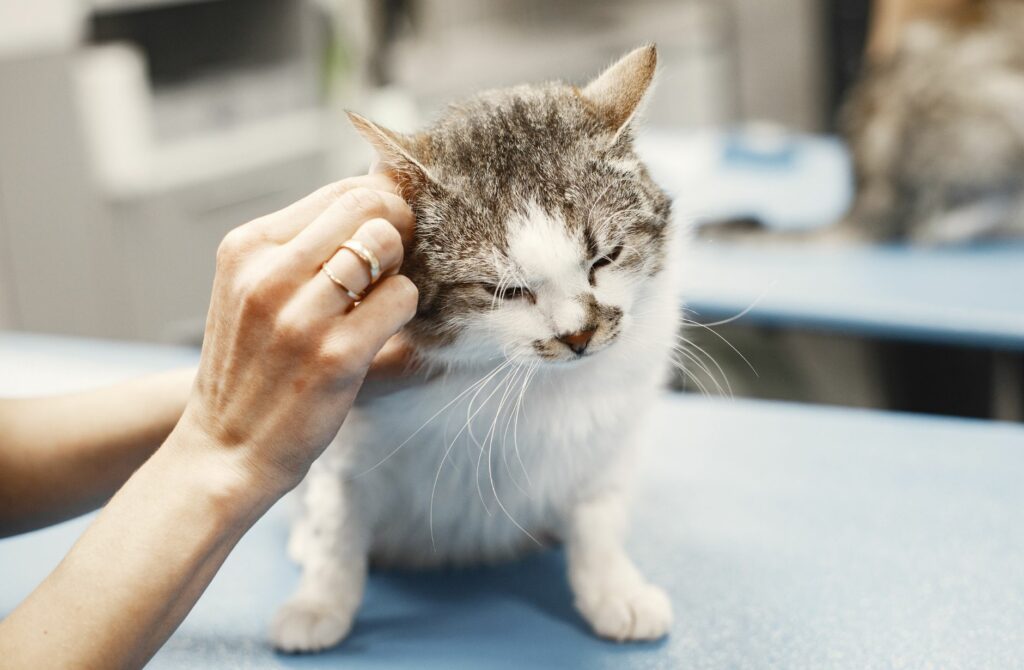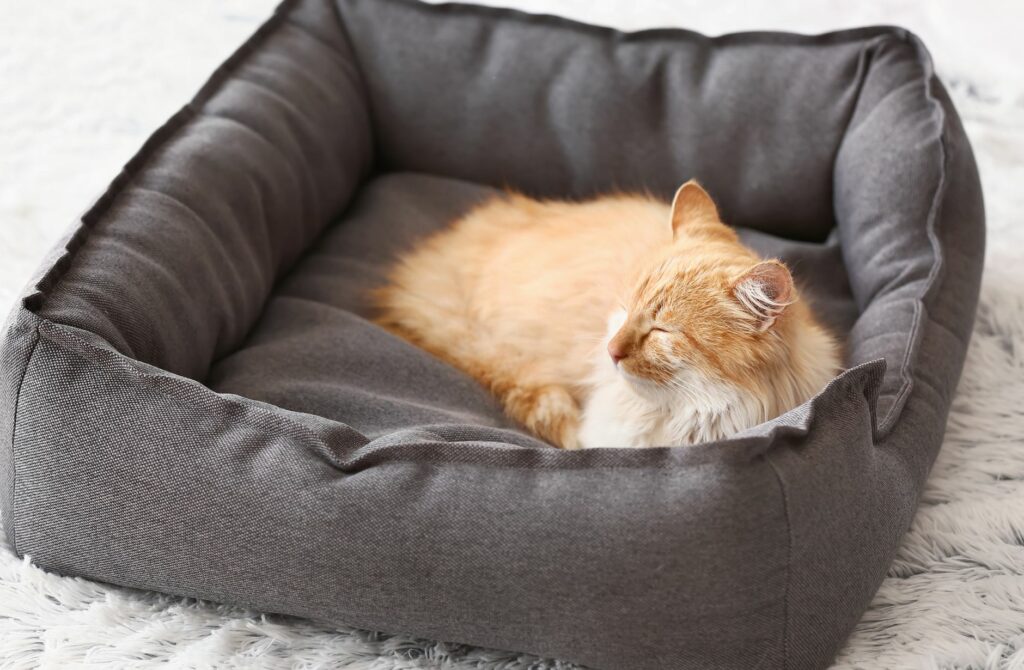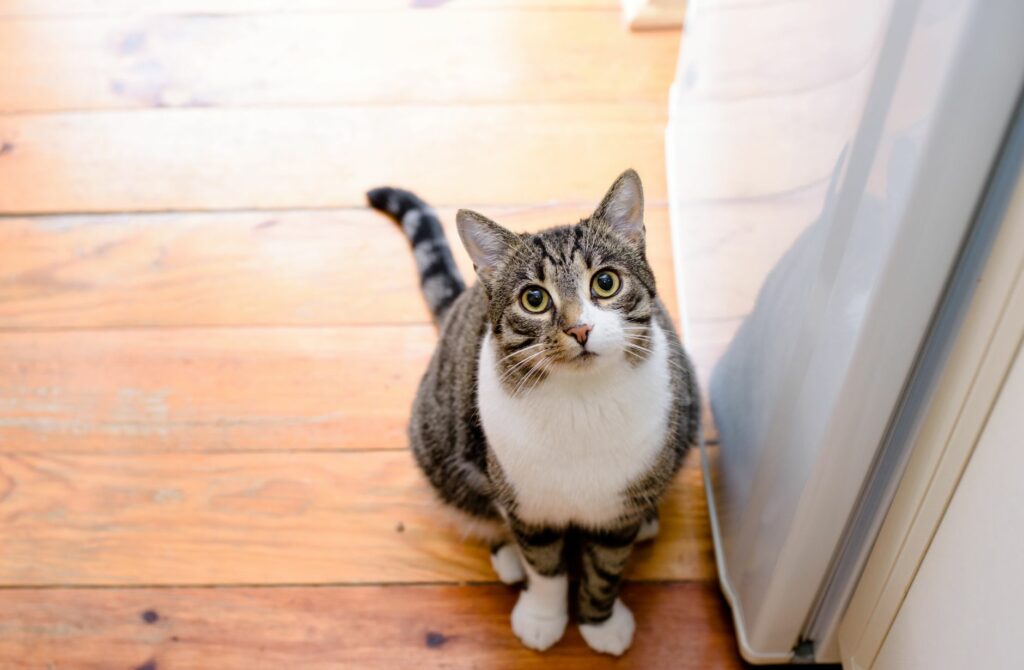Introduction
Discovering how to clean house after cat has tapeworms is crucial for keeping your home and family safe. When your cat has worms, it is essential to clean them thoroughly to prevent contamination, as tapeworms are parasites that live in your cat’s intestines and can be passed through their feces.
Quick Steps:
- Isolate and treat your cat.
- Wear protective gear.
- Gather cleaning supplies.
- Clean pet bedding.
- Vacuum and steam clean carpets and furniture.
- Mop and disinfect hard floors.
- Dispose of waste properly.
Tapeworms can seriously affect your cat’s health, causing weight loss and irritability, and can sometimes lead to human infections. Thorough cleaning helps break the parasite’s life cycle and ensures your home is safe. E.C. House Cleaning specializes in pet-friendly and eco-friendly cleaning solutions, making it easy to maintain a healthy living space.

Table of Contents
Step 1: Isolate and Treat Your Cat
When you discover that your cat has tapeworms, the first crucial step is to isolate the infected cat from other pets. This prevents the spread of worms and gives you a controlled environment to monitor your cat’s condition.
Isolate the Infected Cat
Place both your cat in a separate room where they can be comfortable but away from other pets. Use a room that’s easy to clean, such as a bathroom or a small bedroom, to minimize the spread of any parasites.
Deworming Medication
Next, consult your veterinarian for a deworming medication. Your vet will prescribe a specific type of dewormer, either oral or injectable, tailored to your cat’s needs. Over-the-counter medications are not strong enough to treat tapeworms effectively. According to Dr. Anna Foster, “Only prescription-strength, vet-administered deworming medication is strong enough to get rid of tapeworms.”
Vet Consultation
A visit to the vet is essential not just for the medication but also for a comprehensive health check. Your vet can identify the type of tapeworm and recommend the best course of treatment. They will also guide you on follow-up treatments and preventive measures.
Monitor Your Cat
During the isolation period, keep a close eye on your cat’s health. Maintaining a clean living environment, regular grooming, and cleaning the litter box are crucial for your cat’s health. Look for signs that the medication is working, such as the presence of tapeworm segments in their stool. Ensure that they are eating well and staying hydrated.
By isolating and properly treating your cat, you can effectively start the cleaning process with peace of mind, knowing that you’re addressing the root of the problem. This is the first step in ensuring a tapeworm-free home.
Step 2: Wear Protective Gear

When dealing with a tapeworm infestation, protecting yourself is crucial. Tapeworm eggs can be microscopic, and direct contact with contaminated surfaces or feces can pose health risks. Here’s how to gear up safely:
Rubber Gloves
Always wear rubber gloves when cleaning areas where your cat has been. This minimizes direct contact with any tapeworm eggs that may be present. Disposable gloves are ideal because you can simply throw them away after use, reducing the risk of spreading the contamination. If you use reusable gloves, make sure to disinfect them thoroughly after each cleaning session.
Face Mask
A face mask is essential to protect yourself from inhaling any airborne particles or dust that might be contaminated. This is especially important when vacuuming or cleaning litter boxes, as these activities can stir up tiny particles.
Minimize Contact
While cleaning, try to minimize direct contact with contaminated surfaces. Use tools like mops, scrub brushes, and vacuums to do the heavy lifting. This approach helps reduce the risk of transferring tapeworm eggs to other parts of your home or to yourself.
By wearing protective gear, you ensure that you are safeguarded against potential health risks. This makes the cleaning process not only more effective but also safer for you and your family.
Next, we will gather all the necessary cleaning supplies to tackle the infestation effectively.
Step 3: Gather Cleaning Supplies
To effectively clean your house after discovering your cat has tapeworms, you’ll need the right supplies. Here’s a list of essentials:
1. Steam Cleaner
A steam cleaner is invaluable for deep cleaning. The high temperature of the steam can kill tapeworm eggs and larvae on carpets and upholstery. Make sure to get a model that reaches at least 212°F.
2. Disinfectant Cleaner
Choose a pet-safe disinfectant cleaner to sanitize surfaces. Look for products that are specifically designed to kill parasites. You can also use a homemade solution of water and white vinegar.
3. Hot Water
Hot water is crucial for washing your cat’s bedding, your own bedding, and any fabric items your cat has come into contact with. The heat helps kill tapeworm eggs.
4. Cleaning Cloths
Microfiber cloths are excellent for capturing dust and small particles. Use these to wipe down surfaces like countertops, shelves, and pet accessories.
5. Bleach Solution
In some cases, your vet might recommend using a mild bleach solution to disinfect hard surfaces. If you go this route, mix 1 part bleach with 10 parts water. Always ensure proper ventilation when using bleach.
6. Trash Bags
Use double-layered trash bags to dispose of any waste, including vacuum cleaner contents and soiled items. Seal them tightly and dispose of them in an outdoor trash bin to prevent recontamination.
By gathering these supplies, you’ll be well-prepared to tackle the cleaning process head-on. This ensures a thorough job, reducing the risk of re-infestation and keeping your home safe and clean.
Next, we’ll focus on cleaning your pet’s bedding to ensure no tapeworm eggs are left behind.
Step 4: Clean Pet Bedding

Cleaning your cat’s bedding is crucial to ensure no tapeworm eggs are left behind. Here’s how to do it effectively:
Wash Bedding in Hot Water
First, gather all your cat’s bedding, as it may be contaminated with cat’s feces. This includes blankets, cushion covers, and any other fabric items your cat regularly uses. Washing these items in hot water is essential for killing any tapeworm eggs or larvae.
- Temperature Matters: Use the hottest water setting on your washing machine. According to experts, hot water is effective in killing parasites and their eggs.
- Laundry Detergent: Add a good amount of laundry detergent to help break down any organic matter. This makes it harder for eggs to survive.
Dry on High Heat
Once the washing cycle is complete, the next step is drying.
- High Heat Setting: Transfer the washed bedding to your dryer and use the highest heat setting. High heat effectively kills any remaining eggs or larvae.
- Drying Time: Allow the items to dry completely. If you don’t have a dryer, hang them outside in direct sunlight, which also helps kill parasites.
Pro Tip: If your cat’s bedding is not machine-washable, consider using a steam cleaner. Steam cleaning can effectively sanitize fabrics without damaging them.
Regular Maintenance
To prevent future worm infestations, make it a habit to wash your cat’s bedding regularly. This is especially important if your cat spends time outdoors or has had fleas in the past.
- Weekly Wash: Aim to wash the bedding at least once a week.
- Vacuum Before Washing: For extra cleanliness, vacuum the bedding before washing to remove any loose debris or eggs.
By following these steps, you can ensure your cat’s bedding is free from tapeworms, providing a safer environment for your furry friend.
Next, we’ll focus on vacuuming and steam cleaning to tackle carpets and upholstery.
Step 5: Vacuum and Steam Clean
When dealing with tapeworms, thorough vacuuming and steam cleaning are essential steps to ensure your home is free from parasites. Here’s how to do it effectively:
Vacuum Carpets
Start by vacuuming all carpeted areas in your home to help prevent worm infestation. Tapeworm eggs and segments can easily get trapped in carpet fibers.
- Use a vacuum with a HEPA filter. HEPA filters trap tiny particles, including potential tapeworm eggs, ensuring they don’t get recirculated into the air.
- Vacuum slowly and thoroughly. Pay extra attention to areas where your cat frequently lounges or sleeps.
- Empty the vacuum bag or canister immediately after use. Seal the contents in a plastic bag and dispose of it in an outdoor trash bin to prevent any eggs from re-entering your home.
Steam Clean Upholstery
Steam cleaning is a powerful way to kill any remaining parasites on upholstered furniture.
- Choose a steam cleaner that reaches at least 212°F (100°C). This temperature is effective in killing tapeworm eggs and segments.
- Focus on your cat’s favorite spots. Steam clean all furniture where your cat likes to sit or sleep, including sofas, chairs, and cushions.
- Move slowly and methodically. Ensure the steam penetrates deep into the fabric to kill any hidden parasites.
Kill Tapeworm Eggs
Steam cleaning not only cleans but also sanitizes. The high temperature kills most parasites, including tapeworm eggs.
- Repeat the process. For best results, steam clean your upholstery every few days until you’re confident all parasites are eradicated.
- Combine with regular vacuuming. Continue to vacuum regularly to pick up any new eggs or segments that may appear.
By following these steps, you can effectively reduce the risk of tapeworms in your home. Next, we’ll move on to mopping and disinfecting hard floors.
Step 6: Mop and Disinfect Hard Floors

Once you’ve tackled the carpets and upholstery, it’s time to focus on the hard floors. Tapeworm eggs and segments can easily find their way onto these surfaces, so thorough cleaning is essential.
Disinfectant Cleaner and Bleach Solution
1. Choose Your Cleaner
Use a pet-safe disinfectant cleaner to ensure the safety of your furry friends. If you prefer a stronger solution, a mild bleach mixture works well. Mix 1 part bleach to 10 parts hot water for effective disinfection.
2. Clean Soiled Areas First
Identify and clean any areas that your cat may have soiled, including the cat’s litter box. These spots are likely to harbor tapeworm eggs. Use the disinfectant or bleach solution to scrub these areas thoroughly.
Mopping Hard Floors
1. Hot Water for Mopping
Fill a bucket with hot water and add your chosen disinfectant cleaner or bleach solution. Hot water helps in breaking down any organic material and enhances the effectiveness of the cleaner.
2. Mop Thoroughly
Mop all hard floor surfaces, including tile, laminate, and hardwood. Pay special attention to corners and baseboards where debris can accumulate. Make sure to rinse and wring out your mop frequently to avoid spreading contaminants.
3. Allow to Air Dry
After mopping, let the floors air dry completely. This step ensures that any remaining disinfectant has time to work and that the floors are safe for your pets to walk on.
For Best Results
- Repeat the Process: Mopping and disinfecting should be done daily for the first few days. This helps to ensure that any remaining eggs or segments are eradicated.
- Use Microfiber Cloths: For smaller areas or spots that need extra attention, use microfiber cloths dampened with your cleaning solution. They trap and remove particles more effectively than regular cloths.
By following these steps, you can significantly reduce the risk of tapeworms spreading in your home. Next, we’ll discuss how to properly dispose of waste to prevent re-infestation.
Step 7: Dispose of Waste Properly
Proper waste disposal is crucial to prevent re-infestation and ensure a clean environment. Follow these simple steps:
- Double-Bag Waste: Always double-bag any waste that may be contaminated with tapeworm eggs or segments. This includes used litter, vacuum bags, and cleaning cloths.
- Seal Trash Bags: After double-bagging, make sure to tightly seal the trash bags. This prevents any parasites from escaping and spreading.
- Outdoor Trash Bin: Immediately place the sealed trash bags in an outdoor trash bin. Keeping them outside reduces the risk of contamination inside your home.
By disposing of waste properly, you help to eliminate the risk of tapeworms re-infesting your home. This is an essential step in maintaining a healthy environment for you and your cat.
Next, we’ll discuss post-deworming care to ensure your cat remains healthy and your home stays clean.
How to Clean House After Cat Has Tapeworms

Cleaning your house after your cat has tapeworms is crucial. Tapeworms can spread through tiny segments that your cat might drop around the house. Here’s how to clean house after cat has tapeworms in a few simple steps:
Cleaning Process
- Isolate and Treat Your Cat: First, isolate your cat and follow the vet’s deworming instructions. This stops the spread while you clean.
- Wear Protective Gear: Always wear rubber gloves and a face mask. This keeps you safe from potential parasites.
Vacuuming
- Vacuum Carpets and Upholstery: Use a vacuum with a HEPA filter to clean all carpets, rugs, and upholstered furniture. Pay extra attention to areas where your cat spends most of its time.
- Empty Vacuum Bag/Container: After vacuuming, empty the vacuum bag or container into a sealed trash bag. Dispose of it in an outdoor trash bin.
Steam Cleaning
- Steam Clean Carpets and Furniture: Steam cleaning is highly effective. It kills parasites and their eggs without harsh chemicals. Use a steam cleaner on carpets, upholstery, and other surfaces. Follow the manufacturer’s instructions for best results.
- Focus on High-Traffic Areas: Make sure to steam clean areas where your cat frequently rests or plays.
Disinfecting
- Hard Floors: Mop hard floors with a disinfectant cleaner or a bleach solution mixed with hot water. This includes tile, laminate, and hardwood floors. Clean any areas that might have been soiled by your cat.
- Surfaces: Wipe down all surfaces with a pet-safe disinfectant. Focus on litter boxes, feeding areas, and resting spots. This helps eliminate any remaining parasites.
Post-Cleaning Care
After cleaning, keep monitoring your cat and maintain good hygiene practices. This ensures a healthy environment for everyone in your home. Up next, we’ll discuss post-deworming care to ensure your cat remains healthy and your home stays clean.
Post-Deworming Care
Once you’ve cleaned your home, it’s crucial to focus on post-deworming care. This ensures your cat remains healthy and your home stays parasite-free.
Monitor Cat Health
After deworming, keep a close eye on your cat’s health. Look for signs of improvement, such as:
- Increased appetite
- More energy
- Normal bowel movements
If you notice any unusual symptoms like vomiting, diarrhea, or lethargy, contact your vet immediately. Regular vet check-ups can help catch any lingering issues early.
Indoor Restriction
To prevent reinfestation, keep your cat indoors for a while. Outdoor environments can expose your cat to worm-infested areas, increasing the risk of reinfection.
“By restricting your cat’s access to the outdoors for a period after deworming, you significantly reduce their chances of encountering contaminated soil or coming into contact with other animals carrying parasitic worms” .
This controlled environment helps your cat recover without the risk of encountering new parasites.
Hygiene Practices
Maintaining good hygiene is key to preventing future infestations. Here are some tips:
- Wash Hands: Always wash your hands thoroughly after handling your cat or cleaning the litter box.
- Clean Litter Box Regularly: Even after deworming, clean the litter box daily to prevent any buildup of feces and potential worm eggs.
- Sanitize Feeding Areas: Regularly clean and sanitize your cat’s food and water bowls to minimize bacterial contamination.
- Flea Prevention: Fleas are carriers of tapeworms. Use flea prevention treatments and regularly comb your cat with a flea comb to prevent the ingestion of infected fleas.
By following these hygiene practices, you can create a safer and healthier environment for your cat.
In the next section, we’ll address frequently asked questions about cleaning after your cat has had tapeworms.
Conclusion
At E.C. House Cleaning, we understand that dealing with a tapeworm infestation in your home can be stressful. Our goal is to help you maintain a clean and healthy environment for both you and your pets.
We use eco-friendly products that are safe for your pets and the environment. These products effectively clean and disinfect your home without exposing your family to harsh chemicals.
Our personalized pricing ensures that you get the best value for your money. We tailor our services to meet your specific needs, whether it’s a one-time deep clean or regular maintenance.
Based in Massachusetts, we are committed to providing top-notch residential cleaning services to our community.
Contact us today. Our team of professionals is trained to handle all types of cleaning challenges, including pet-related issues like tapeworms.
For more information or to schedule a cleaning service, visit our Residential Cleaning Services Massachusetts page.
By following the steps outlined in this guide and taking advantage of our expert cleaning services, you can ensure a clean and healthy home for your family and pets.
Frequently Asked Questions about Cleaning After Cat Has Tapeworms
Do I need to treat my house if my cat has tapeworms?
Yes, you do. Intestinal parasites, such as tapeworms, can spread through your home via your cat’s feces. Examining your cat’s feces for signs of worm infestation, such as the appearance of tapeworm eggs or segments, is crucial. Even though the worms themselves are primarily in the intestines, their segments can break off and be found in your cat’s litter box, bedding, or even on the floor.
Infestation Prevention: To prevent a full-blown infestation, it’s crucial to clean your house thoroughly. This means washing all your cat’s bedding, vacuuming carpets, and disinfecting surfaces.
How do I disinfect my house from tapeworms?
Disinfecting your house involves several steps to ensure all potential tapeworm eggs and segments are removed:
- Steam Cleaning: Use a steam cleaner on carpets and upholstery. The heat can kill any remaining eggs or larvae.
- Antibacterial Cleaner: Wipe down all hard surfaces with an antibacterial cleaner to remove any contaminants.
- Mild Bleach Solution: For areas like the litter box or heavily soiled spots, a mild bleach solution can be effective. Mix one part bleach with ten parts water for a safe and strong disinfectant.
- Hot Water: Wash all pet bedding and any fabric items your cat has come into contact with in hot water. Dry on high heat to kill any remaining parasites.
Can tapeworms live on bedding?
Yes, they can. Tapeworm segments can end up on your cat’s bedding and potentially spread to other areas of your home. Tapeworms can also be transmitted to humans and other pets by ingesting infected fleas, so practicing good hygiene and taking precautions is essential.
Bedding Contamination: It’s essential to wash all bedding in hot water and use a high-temperature dryer setting. This ensures that any tapeworm segments or eggs are killed.
Inflammatory Reactions: While rare, some people may experience inflammatory reactions if they come into contact with tapeworm segments. This is another reason why thorough cleaning is crucial.
By following these steps, you can effectively clean your house and minimize the risk of tapeworm reinfestation.
Next, we’ll discuss post-deworming care to ensure your cat remains healthy and your home stays clean.
Our Content
All content is written by E.C. House Cleaning’s professional cleaning company for Boston Maid Service. We put our expertise in house cleaning services into each piece of content, focusing on providing valuable, accurate, and relevant information. With over 20 years of deep, full cleaning service industry experience in the Massachusetts and Boston area with a proven track record of pet-friendly cleaning services in Massachusetts, pet friendly carpet cleaners, residential deep cleaning, Massachusetts attic cleaning, and trust for customers as signaled by our hundreds of 5-star reviews, E.C. House Cleaning is an authority on residential and commercial cleaning services.
